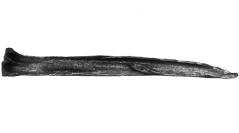

 Anthropozoologica
54 (4) - Pages 29-43
Anthropozoologica
54 (4) - Pages 29-43This paper focuses on the identification and interpretation of a sample of vertebrate faunal remains from the Croxton archaeological site, located at Tukuto Lake, on the north slope of the Brooks Mountain Range, Alaska, in which caribou (Rangifer tarandus (Linnaeus, 1758)) dominate. Bone modifications are assessed to inform selection and processing, and skeletal part frequencies are analyzed with utility indices developed for this species among the Nunamiut at Anaktuvuk Pass. Results confirm the accumulation of faunal remains resulted primarily from human subsistence activities in the middle to late Holocene that included nutritional uses for meat, marrow and grease as well as technology manufacturing. Statistical utility analyses point to a deposit of marrow and grease processing debris at an activity area and support these as enduring subsistence practices in this region. A previous study on a larger faunal sample from the site also indicated a range of economic uses of caribou but did not find significant results with utility indices. To explain this difference it is suggested that the faunal aggregates chosen for analysis in this and the previous study have influenced statistical outcomes. The results of this study hold implications for utility analysis as well as for interpretations of caribou use at archaeological sites in arctic, sub-arctic, and alpine tundra areas of the Northern Hemisphere where this species has been abundant.
Archaeology, utility indices, zooarchaeology, taphonomy, Rangifer tarandus, North America, Alaska.